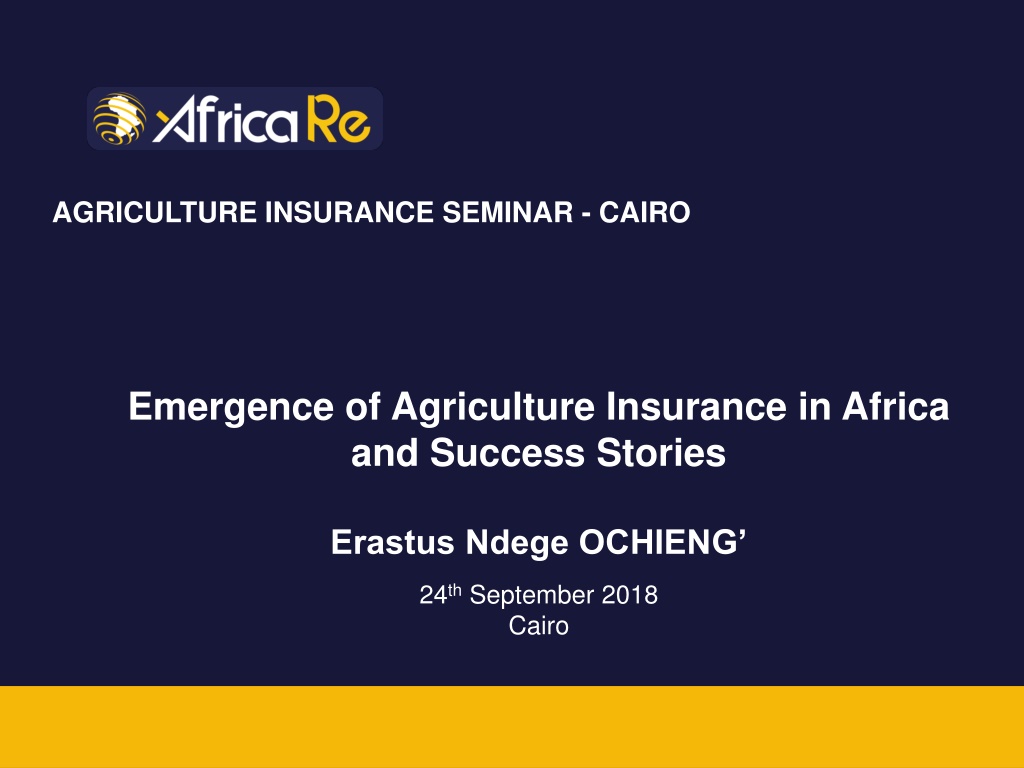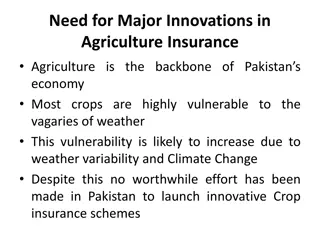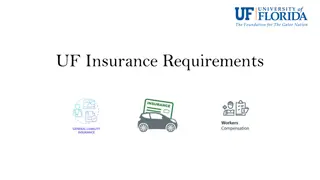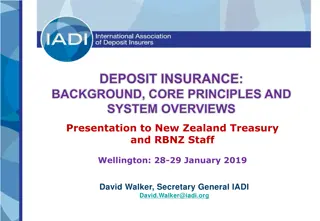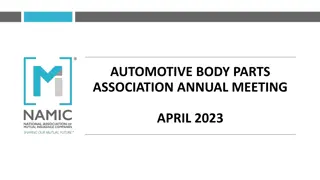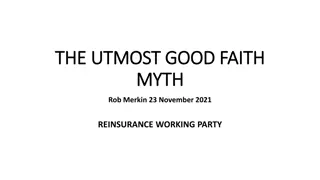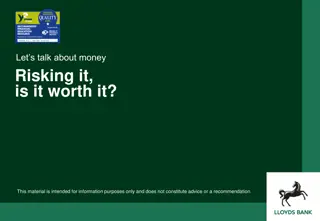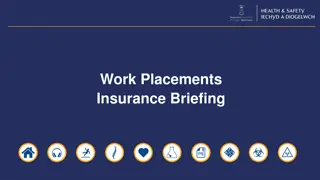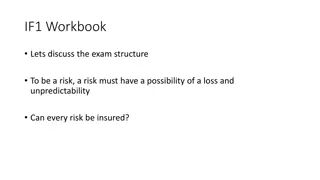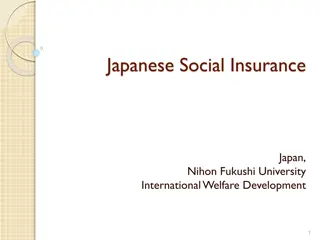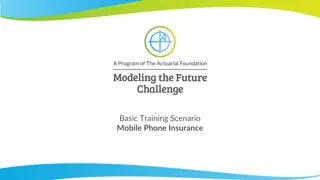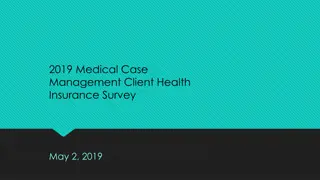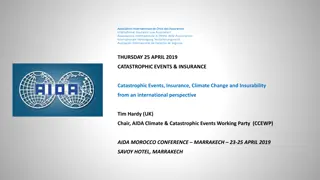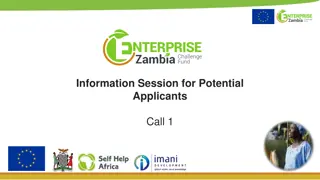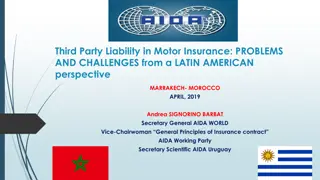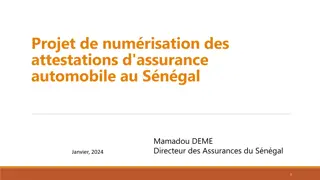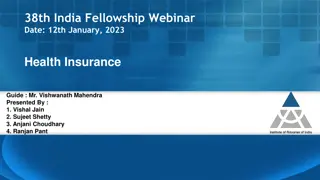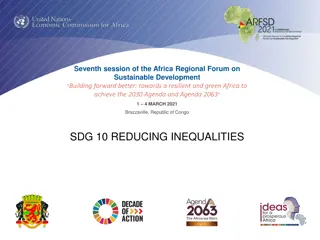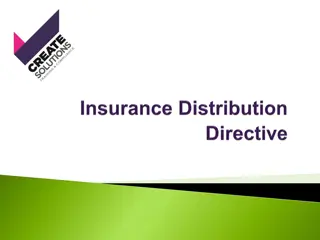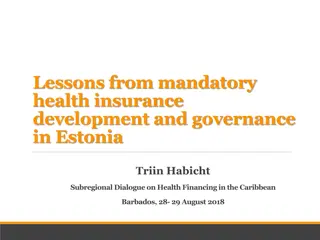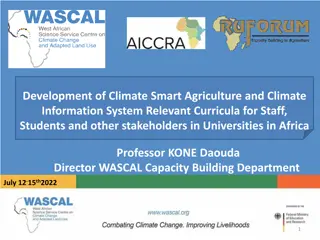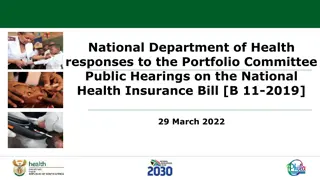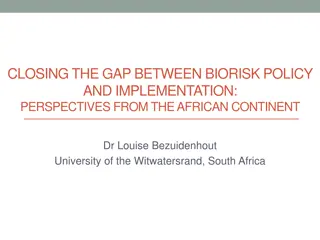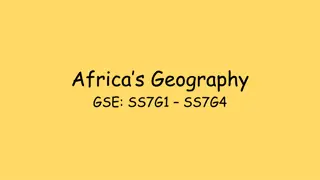Emergence of Agriculture Insurance in Africa: Challenges and Opportunities
Agriculture is integral to Africa's economy, yet the majority of farmers lack insurance protection, leaving them vulnerable to risks. Despite advancements in agriculture insurance globally, Africa lags, with limited premium volumes. The seminar explores the potential for growth, historical evolution, and global perspectives, emphasizing the need for increased insurance adoption to safeguard farmers and enhance agricultural resilience.
Download Presentation

Please find below an Image/Link to download the presentation.
The content on the website is provided AS IS for your information and personal use only. It may not be sold, licensed, or shared on other websites without obtaining consent from the author. Download presentation by click this link. If you encounter any issues during the download, it is possible that the publisher has removed the file from their server.
E N D
Presentation Transcript
AGRICULTURE INSURANCE SEMINAR - CAIRO Emergence of Agriculture Insurance in Africa and Success Stories Erastus Ndege OCHIENG 24thSeptember 2018 Cairo
GLOBAL AND CONTINENTAL PERSPECTIVES
Introduction Agriculture is the main economic activity in most African Countries contributing greatly to GDP and is the main source of livelihood for a majority of the populace. Over 70%of Africa`s population rely on agriculture for survival and yet less than 1% are protected from production disruptions through insurance. Farmers are faced by quite a number of risks which always render them vulnerable and at times leading to poverty traps. The growth of agriculture insurance in Africa is still on the formative stages with great potential for growth Most governments are beginning to consider insurance as an efficient and effective way of addressing catastrophe social protection measure. 3
In spite of the risks famers face, Insurance is not among the coping mechanisms they prioritize on 4
Evolution of Agriculture Insurance 1993 Area Yield Insurance Pilot in 1993 based on 1990 farm act in USA 2004 Index - India 1920-1938 Federal Crop Insurance Act (USA) 1981 Revenue Insurance 1791 Crop Hail Insurance in Germany There has been a lot of activities in the recent past on agriculture insurance with innovations on index based crop and livestock insurance, the use of satellite index insurance products and exploration on the use of drone technology 5
Distribution of total written premium globally Source: World Bank 2009 As at 2017, the total premium volume for Africa stood at approximately USD 250million out of which estimates show USD 150million was from South Africa and the rest from the other countries i.e. Morocco, Zambia, Zimbabwe, Algeria, Tunisia, Kenya, Ethiopia as some of the key contributors 6
Distribution by product globally Source: World Bank 2009 o Crop insurance is the most developed line accounting for about 90% of the written premium worldwide. o MPCI dominant in the USA and Canada, Named peril dominant in Europe. Africa Hail Insurance in South Africa 7
Source: ISF 2018 10
NO. OF SMALL HOLDER CONTRACTS 1,200,000.00 1,000,000.00 800,000.00 600,000.00 400,000.00 200,000.00 - Planet Guarantee (Burkina Faso) ILRI and partners (Ethiopia and Kenya) MicroEnsure (Rwanda) Planet Guarantee (Senegal) Pula (Kenya, Rwanda, Uganda, Nigria, Ethiopia, Malawi) ACRE Africa (Kenya, Tanzania, Rwanda) Risk Shield/Agriservices (Zambia) There have been several initiatives in the continent as from 2000 but very few have managed to reach scale Some of the projects that have reached scale have mainly been supported by either donors, development agencies or through government agencies Some of the projects are just at the point of gaining traction Sources: Global Index Insurance facility s country reports ILRI website 11
NO. OF CONTRCTS MAJOR COUNTRIES GLOBALLY (in'000) India Turkey Mexico - 10,000 20,000 30,000 40,000 50,000 60,000 Synergies between private sector players, government and development organizations towards the development of the insurance environment are key towards growth 12
ACRE AFRICA Started operations in 2009 as a project run by the Syngenta Foundation for Sustainable Development in partnership with UAP Insurance. The program later developed to a scheme known as Kilimo Salama in 2010. With continual growth it formed into a social business in 2014, transforming to the currently known ACRE Africa It is the first agricultural insurance project worldwide to reach farmers by the use of mobile phones Farmers purchase insurance together with the farming inputs from local stockists along at an affordable premium on the retail price. Premiums are subsidised by input manufacturing companies who match the premium paid by the farmer. Development organizations like the International Finance Corporation have previously also offered subsidies either as a direct rebate to the insurance or to minimize the distribution costs Operations: Kenya, Rwanda, Tanzania Products: Index Based Weather Insurance, Index Based Satellite Insurance, Area Yield Index Insurance, Hybrid of Index Based and Area Yield Insurance Contracts Sold: 1.6 million as per 2017 estimates up from 200 farmers in 2009 when they launched Success factors: Effective partnerships, Use of technology, Low Cost Distribution channels 14
ACRE AFRICA Syngenta Foundation International Finance Cooperation Lundin Foundation Weather Monitoring partners Min. of Agriculture Development organisations Government Agencies Distribution channels Private Sector SACCOs Mobile Network Operators Agrovets Insurance Companies Financial Institutions Input Manufacturers 15
INDEX BASED LIVESTOCK INSURANCE (IBLI) Piloted in 2010 in Marsabit Kenya by the International Livestock Research Institute after 3 years of research activities. Later expanded to other regions in Northern Kenya and Southern Ethiopia (Borana region) Product offered is a pasture Vegetative Index Insurance that protects pastoralist farmers against lack of pasture as a result of drought As from 2016, the government of Kenya entered into a partnership with insurance companies to offer subsidies to the most vulnerable households. As from 2018, there is a partial subsidy introduced targeting those not targeted with the full subsidy Success Factors: Effective partnerships, Innovative index, Low transaction costs due to reduced loss monitoring and contract enforcement costs through satellite technology 16
IBLI Weather Monitoring partners State Department of Livestock OromiyaPastoral Area Development Commission International Livestock Research Institute Index Insurance Innovation Initiative DFID USAID AusAID Development organizations Government Agencies Distribution channels Private Sector Insurance Companies Financial Institutions SACCOS World Vision Mercy Corps Solidarites International 17
FARMER INPUT SUPPORT PROGRAM (FISP) Product offered by the government of Zambia piloted in 2017 The Insurance program built on an infrastructure that had been developed by the government where farmers receive input subsidies through an e-voucher system Payments are automatically triggered to the e-voucher based on comparison between satellite data and the weather index The product developed is a satellite based index insurance product Figures: Total number of farmers covered are 1,059,214 Premium USD 10 million Claim at end of season USD 5.8 million Number of farmers compensated 424,954 18
FISP Global Index Insurance Facility World Food Program Ministry of Agriculture Government Extension workers Development organizations Government Agencies Distribution channels Private Sector E-Voucher vendor Government through FISP program Insurance Companies - Mayfair Risk Shield 19
KEY LESSONS Partnerships are key in the scale up of agriculture insurance to small scale farmers in Africa PPP models Governments play a key role in stimulating demand either through introduction of subsidy programs or creation of an enabling environment for business growth by implementing enabling policies, supporting distribution systems, and awareness creation. Technology and Digitization is a key driver in the distribution channel whether through Mobile Network Operators, Financial Institutions, Mobile Wallets. Innovations will be key enablers of the next growth frontiers. Technologies like the use of drones, soil sensor indices, Blockchain and Artificial Intelligence technologies New non traditional distribution systems open up new markets. Examples include seed companies, development organizations like the World Food Program, Social Programs like the One Acre Fund etc 20
